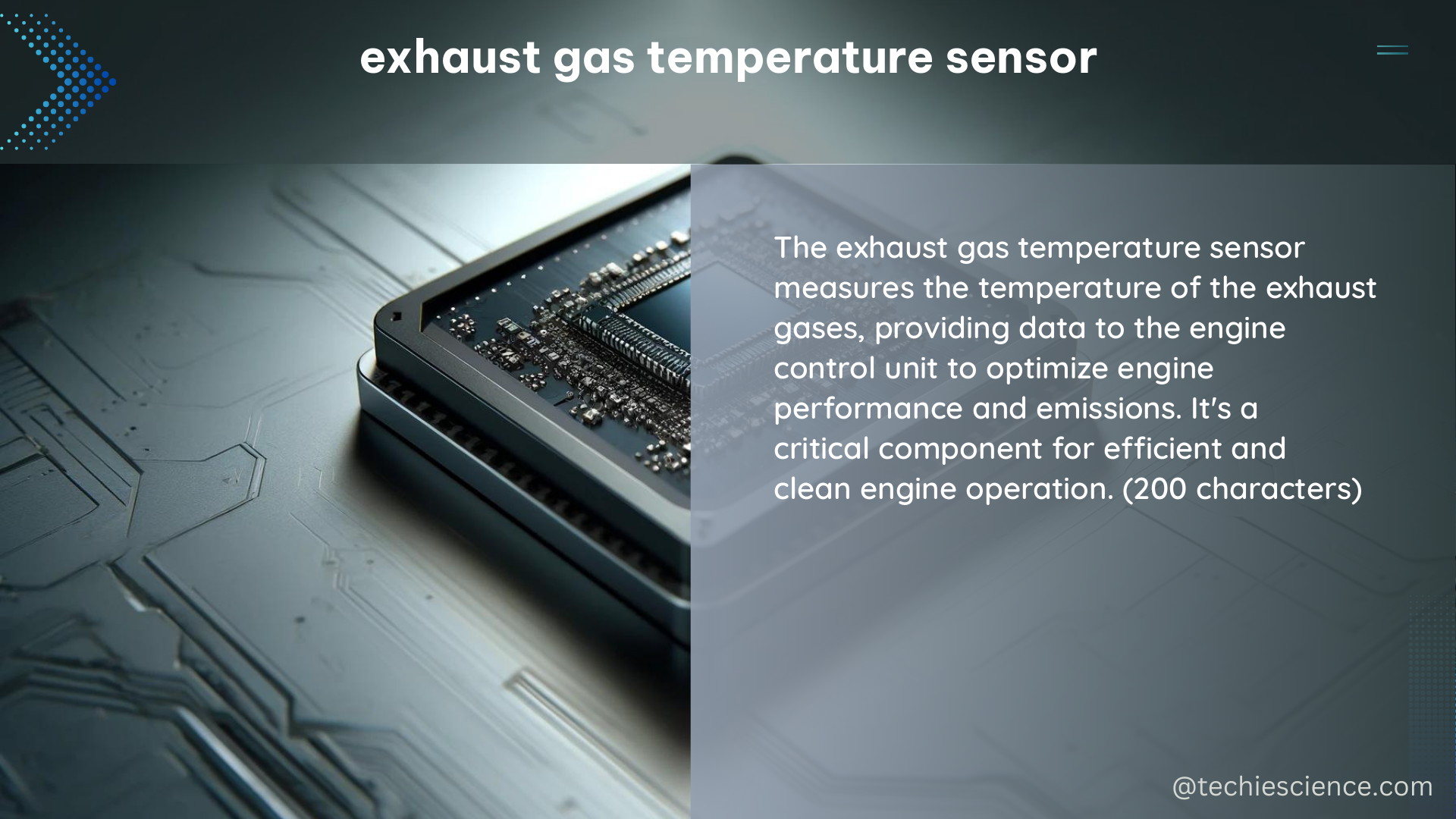The exhaust gas temperature sensor is a critical component in modern internal combustion engines, including gasoline and diesel engines, as well as in gas turbines. It measures the temperature of the exhaust gases, which is an essential parameter for engine performance, fuel efficiency, and emissions control.
Understanding the Exhaust Gas Temperature Sensor
The exhaust gas temperature sensor is typically located in the exhaust manifold or the exhaust pipe, close to the engine cylinders. It consists of a temperature-sensitive element, such as a thermocouple or a resistance temperature detector (RTD), and a signal conditioning circuit that converts the temperature signal into an electrical signal that can be processed and displayed by the engine control unit (ECU) or the gas turbine control system.
Temperature Range
The temperature range of the exhaust gas temperature sensor is the range of temperatures over which the sensor can operate without significant degradation or failure. For example:
- Gasoline engine: -40°C to 1000°C
- Diesel engine: -40°C to 1200°C
- Gas turbine: 0°C to 1400°C
Accuracy
The accuracy of the exhaust gas temperature sensor is the degree to which the sensor measures the true temperature of the exhaust gases. The accuracy is usually expressed as a percentage of the full-scale range or as a temperature difference. For instance:
- ±2% of the full-scale range
- ±10°C, whichever is greater
Response Time
The response time of the exhaust gas temperature sensor is the time it takes for the sensor to respond to a step change in the temperature of the exhaust gases. The response time is usually expressed in seconds or milliseconds. For example:
- 50 milliseconds
- 100 milliseconds
- 200 milliseconds
Thermal Mass
The thermal mass of the exhaust gas temperature sensor is the amount of heat that the sensor can absorb or dissipate without significant changes in its temperature. The thermal mass is usually expressed in joules or calories. For example:
- 100 joules
- 50 calories
- 75 joules
Durability
The durability of the exhaust gas temperature sensor is the ability of the sensor to withstand the harsh conditions of the exhaust gas environment, such as high temperatures, vibrations, and corrosive gases. The durability is usually expressed in terms of the sensor’s lifetime or the number of operating hours. For instance:
- 10,000 hours
- 15,000 hours
- 20,000 hours
Diagnostic Features
In addition to the technical specifications, the exhaust gas temperature sensor may also have some diagnostic features, such as a self-diagnostic function that can detect and report any malfunctions or failures of the sensor. This can help in identifying and troubleshooting issues with the sensor and the overall engine or gas turbine system.
Importance of the Exhaust Gas Temperature Sensor

To illustrate the importance of the exhaust gas temperature sensor, let’s consider the example of a gasoline engine with a three-way catalyst (TWC) for emissions control. The TWC is designed to convert the harmful exhaust gases, such as carbon monoxide (CO), hydrocarbons (HC), and nitrogen oxides (NOx), into harmless gases, such as carbon dioxide (CO2), water (H2O), and nitrogen (N2). The TWC operates at a high temperature, typically between 300°C and 600°C, to promote the chemical reactions that convert the exhaust gases.
If the exhaust gas temperature is too low, the TWC may not operate efficiently, and the emissions of CO, HC, and NOx may exceed the regulatory limits. On the other hand, if the exhaust gas temperature is too high, the TWC may overheat and suffer from thermal degradation or even failure. Therefore, the exhaust gas temperature sensor plays a critical role in maintaining the optimal temperature of the exhaust gases and ensuring the proper operation of the TWC.
Conclusion
The exhaust gas temperature sensor is a vital component in modern engines and gas turbines, and its performance is crucial for engine performance, fuel efficiency, and emissions control. The technical specifications of the exhaust gas temperature sensor, such as the temperature range, accuracy, response time, thermal mass, and durability, are important parameters that determine the sensor’s suitability for a particular application. By understanding the role and characteristics of the exhaust gas temperature sensor, you can ensure the proper operation and maintenance of your engine or gas turbine system.
References:
- Recommended Practices for Measurement of Gas Path Pressures and Temperatures in Gas Turbine Engines, SAE AIR 1271/1, SAE International, 2002.
- Exhaust Gas Temperature Sensor, Bosch Automotive Aftermarket North America, LLC, 2021.
- Exhaust Gas Temperature Sensor, Delphi Technologies, 2020.
- Exhaust Gas Temperature Sensor, Denso Corporation, 2021.
- Exhaust Gas Temperature Sensor, Continental Automotive Systems, Inc., 2020.
- Exhaust Gas Temperature Sensor, ACDelco, 2021.
- Exhaust Gas Temperature Sensor, Standard Motor Products, Inc., 2020.
- Exhaust Gas Temperature Sensor, Federal-Mogul Motorparts, 2021.
- Exhaust Gas Temperature Sensor, NGK Spark Plug Co., Ltd., 2020.
- Exhaust Gas Temperature Sensor, Walker Products, 2021.

The lambdageeks.com Core SME Team is a group of experienced subject matter experts from diverse scientific and technical fields including Physics, Chemistry, Technology,Electronics & Electrical Engineering, Automotive, Mechanical Engineering. Our team collaborates to create high-quality, well-researched articles on a wide range of science and technology topics for the lambdageeks.com website.
All Our Senior SME are having more than 7 Years of experience in the respective fields . They are either Working Industry Professionals or assocaited With different Universities. Refer Our Authors Page to get to know About our Core SMEs.